Petro Konashevych-Sahaidachny
Petro Konashevych-Sahaidachny (Ukrainian: Петро Конашевич-Сагайдачний; Polish: Piotr Konaszewicz-Sahajdaczny; born near 1582[2] in Kulchytsi, today Sambir Raion – April 20, 1622 in Kiev) was a Ukrainian political and civic leader, Hetman of Ukrainian Zaporozhian Cossacks from 1616–1622,[2] a brilliant military leader of Polish-Lithuanian Commonwealth both on land and sea. While being a Cossack Hetman, he transformed the Cossack Host from the erratic military formation into regular army. Under his leadership the cossacks, the Orthodox clergy and peasants had been begun to emerge as the united nation. His troops played a significant role in the battle of Khotyn against the Turks in 1621 and prince Władysław's attempt to gain the Muscovy throne in 1618.[3]
Petro Konashevych-Sahaidachny Петро Конашевич-Сагайдачний | |
|---|---|
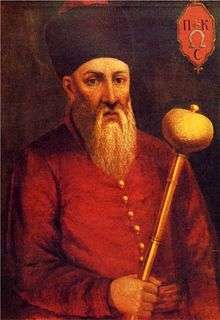 | |
| Hetman of the HRG Host of Zaporizhia | |
| In office 1616–1622 | |
| Preceded by | Vasyl Strilkovsky[1] |
| Succeeded by | Olifer Holub[1] |
| Personal details | |
| Born | near 1582[2] Kulchytsi, Polish-Lithuanian Commonwealth (now Ukraine) |
| Died | April 20, 1622[2] Kyiv, Polish-Lithuanian Commonwealth (now Ukraine) |
Early life
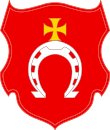
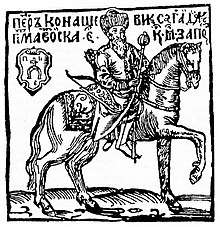
Petro Konashevych was born in Polish-Lithuanian Commonwealth in the village of Kulchytsy (Przemyśl land) three miles away from Sambir in the Ruthenian Voivodeship into a Ukrainian Eastern Orthodox noble family. His father's surname was Kononovych.[4] He graduated from Ostroh Academy in Volhynia. His school mate was Meletiy Smotrytskyi, author of the Hramatyka book, by which many generations of Ukrainians, Russians, and Belarusians learned the Slavic language grammatics. From an early age he learnt the weapon and horsemanship skills. He joined to the cossacks of Zaporozhian Host and took a part in cossack military expeditions to Moldavia in 1600 and Livonia in 1601. His talent in a military strategy, courage and ability to show leadership under great adversity and hardship were acquired by cossacks leader (otaman) Samiylo Kishka. Later, Sahaidachny moved to Lviv, and after to Kyiv, where he became the assistant and tutor of the Kievan judge I. Aksak family.
Major campaigns
Early Turkish campaign
By the end of the 16th century, Sahaidachny traveled to Zaporizhia, where in 1605, he was elected as a kosh otaman of the Zaporozhian Host cossacks. Under his control, the Host participated in campaigns against the Crimean Tatars and the Turks. The Сossacks fleet captured the Turkish fortress Varna, burned and destroyed a strong Turkish navy (10,000 boats). He is famous for his sea sorties on Crimea and Turkey and in 1616 captured Caffa (Feodosia) on the Crimean peninsula, the largest center of the slave trade. He released from slavery many Christian men, women and children.
Muscovite campaign
In 1618, Sahaidachny joined the Anti-Turkish Holy League.[4] While he was battling the Turks, the Polish-Lithuanian Commonwealth requested his assistance for war with Muscovy (Russian Tsardom); they wanted him to provide Władysław IV Vasa, the King of the Polish-Lithuanian Commonwealth, with 20,000 Cossacks near Moscow. Sahaidachny did, and seized the forts in the cities of Putivl, Kursk, Livny, Yelets and many others. Near Serpukhov Sahaidachny forced the Muscovite army to flee. The Muscovite troops under command of the voivode G. Volkonsky forced Cossacks to take a detour, but were unable to stop the advance of the Cossacks regiments to Moscow. In September 1618 he forced to flee the army of another Muscovite nobleman Vasilii Buturlin. Later, united army of Jan Karol Chodkiewicz and Sahaidachny sieged Moscow and 11 October unsuccessful attempted to take the Arbat Gates.
In late October, the army of Sahaidachny moved in raid towards the south from Moscow. During this raid was captured the Serpukhov city and in early December the Kaluga city. John III Sobieski wrote that this successful raid caused panic among Russians and forced them to conclude negotiations as soon as possible. The whole campaign finally culminated in December 1618 by signing the Truce of Deulino, resulting in the greatest territorial expansion of the Commonwealth.
The cossack's invasion of Muscovy has been described by Ukrainian historian Valery Smolyi as "not the best page of Sahaidachny biography".[5] Sahaidachy and his cossacks had been positioning themself as a supporters of the Orthodox Christianity and a potential ally of the Muscovy.[6] However, they left the "bloody trace" which extended from Livny to Moscow and back to Kaluga and Kyiv.[7] In research of Russian, Ukrainian and American historians Cossacks have been blamed for destroying and robbing of Orthodox churches, cities, villages, killing children and women, who belonged to Orthodox (Greek) Christianity.[8][9][10] Later, Sahaidachny asked Patriarch Teophanes III of Jerusalem to forgive him for such behavior.[6]
Sahaidachny returned to Zaporizhia, and did not only become a kosh otaman, but was also the Hetman of Ukraine. (Another source claims that in 1621 he was a colonel of the Commonwealth Registered Cossacks regiment).[6] In order to avoid conflict with the Poles, Sahaidachny agreed to limit the Cossack register to 3,000 men, the remainder were regarded as peasants ("kholopy"). He also banned unauthorized Cossack sea raids to Turkey and the king gave Sahaidachny the right to be called an elder of the Cossacks("starshina").[11]
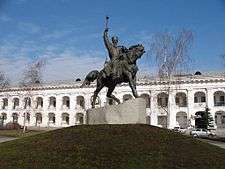
Restoration of the Ukrainian Orthodox hierarchy
Not only did Sahaidachny fight for control, he also fought for the religious and cultural rights of the Ukrainian people. In 1620, he registered himself and his entire Zaporozhian Host as students into the Kyiv Epiphany Brotherhood School, that preceded the current Kyiv Mohyla Academy. It was done in order to protect the school from conversion from an Orthodox school into a Roman Catholic Jesuit Collegium. He also contributed to the establishment of a cultural center in Kyiv and sought to unite the Cossack military with the Ukrainian clergy and nobility.
In early 1620 Sahaidachny sent an envoy to the Russian tsar. At this time there was the Patriarch Teophanes III of Jerusalem and this envoy held talks with him about the possibility of his arrival in the Ukraine.
In 1620, Sahaidachny convinced Patriarch Teophanes III, who recently returned from Moscow, to reconstruct the Orthodox hierarchy, that was almost destroyed by the creation of the Greek-Catholic Church.
Patriarch Teophanes III of Jerusalem blamed Cossacks for the participation in the Muscovy campaign saying that the damnation have been put on them for this, because Muscovites are the Orthodox Christians and in a future they never would fight again against them.[12][13]
The patriarch appointed Iov Boretsky as a Kievan Metropolitan bishop and five other bishops at the same time.[4] Because the Polish-Lithuanian Commonwealth had threatened to arrest Teophanes III as a spy, Sahaidachny was guaranteed his protection by the patriarch. After the new metropoliten and bishops were installed, Sahaidachny escorted the patriarch to the Ottoman border with a 3,000 men Cossack army.[11]
Later life and death
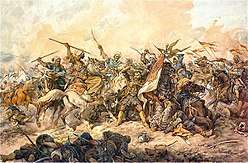
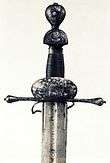
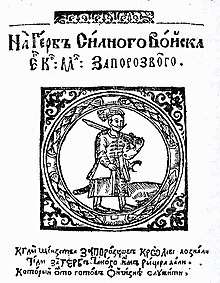
The Polish-Lithuanian Commonwealth accepted the appointment, because it wanted to keep close contacts with Sahaidachny after the Turks defeated the Polish army at the Battle of Ţuţora.
Because of Sahaidachny's moderate policies towards Commonwealth, he provoked dissatisfaction among the Cossacks, and in 1620, they briefly elected Yatsko Borodavka as hetman.[4] In 1621, the famous Battle of Khotyn had occurred, where close to 80,000 Cossacks and Polish troops fought against 160,000 Turkish army. The battle held at bay for a whole month, until the first snow compelled Osman II to withdraw his weakened forces.[14] Sahaidachny and his army played a significant role in the battle, forcing the Turks to sign an unfavorable peace treaty. During the battle, Sahaidachny was seriously wounded. After the battle, the Polish king sent Sahaidachny a sword in recognition of his services.
On April 20, 1622, Sahaidachny died in Kyiv from wounds he suffered at the Battle of Khotyn. He was later buried in the Bratsky Monastery of Kyiv.[15] He left his assets to the brotherhood schools in Kyiv and Lviv for church causes.[4] His legacy was so great, that most of the population of Kyiv attended his funeral en masse.[11] Sahaidachny's work, About Union, was highly regarded by the Lithuanian Kanclerz Lew Sapieha.[16] In 1646, John III Sobieski, a monarch of the Polish-Lithuanian Commonwealth, said the following about Sahaidachny:
He was a man of great spirit who sought danger, did not care about his own life, was swift and energetic in battle, cautious, slept little and was sober... was careful at discussions, and non-talkative in conversations.[17]
— John III Sobieski, 1646
Polish historian Jan Widacki wrote that Konashevych-Sahaidachny was among Zaphorozian hetmans the one most loyal to Poland.[18] He was a supporter of the Polish-Ukrainian military cooperation against the enemies of the Commonwealth.[19][20]
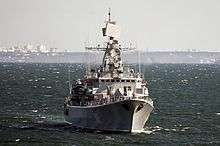
Legacy
- Frigate "Hetman Sahaidachny" – a flagship of the Ukrainian Navy for over 20 years.
- National Ground Forces Academy in Lviv is named after hetman Petro Sahaydachyi.[22][23]
- After the March 2014 Russian annexation of Crimea the monument to Konashevych-Sahaidachny in Sevastopol was removed and handed over to Kharkiv.[24] (Where it was unveiled in August 2015.[25])
- In 2001 a monument dedicated to Petro Konashevich-Sagaydachniy was erected in Kyiv, Ukraine, on Kontraktova square. The authors of the monument are Valeriy Shvetsov, Oles Sydoruk and Boris Krylov.
| Part of a series on |
| Cossacks |
|---|
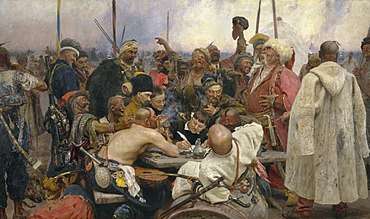 |
| Cossack hosts |
| Other groups |
| History |
| Cossacks |
| Cossack terms |
See also
References
- Сас П. М.,Кіркене Г. Хотинська битва 1621 – битва за Центральну Європу
- http://history.org.ua/?termin=Konashevich_Sagaidachny
- Nataliia Polonska-Vasylenko (1992). History of Ukraine. 1. "Libid" press Kyiv. p. 440. Adrian Kashchenko (1917). A Short History of the Zaporozhian Host (4th ed.). Ukrainian press in Katerinoslav, Leipsig, Germany. pp. 91–92.
- Wynar, L.; Zhukovsky, A. "Konashevych-Sahaidachny, Petro". Encyclopedia of Ukraine.
- Valery Smolyi, Peter Sahadachny: knight, politician, man. Vitchizna, 13, #1, 189-194 (1990)(Валерій Смолий, Петро Сагайдачний: воїн, політік, людина. Вїтчизна, 13, №1, 189-194 (1990)) ,"Archived copy". Archived from the original on 2015-01-01. Retrieved 2013-04-03.CS1 maint: archived copy as title (link)
- Valery Smolyi, Peter Sahadachny: knight, politician, man. Vitchizna, 13, #1, 189-194 (1990)(Валерій Смолий, Петро Сагайдачний: воїн, політік, людина. Вїтчизна, 13, №1, 189-194 (1990)) , Archived 2014-11-13 at the Wayback Machine
- Bel'sk monastery script, Full Collection of the Russian Chronicles, v.34, page 266 (ПСРЛ (Полное собрание русских летописей) т. 34, Бельская летопись, стр 266)
- Dmitry Yavornitsky, History of Zaporozhian Cossacs, v.2, chapters 9-10, (Дмитрий Иванович Яворницкий ИСТОРИЯ ЗАПОРОЖСКИХ КАЗАКОВ История запорожских казаков. Киев.: Наук. думка, 1990. - Т. 2. - 660 с. Академия наук Украинской ССР, Археографическая комиссия, Институт истории , Главы 9-10,)
- G.V. Vernadsky, "Moscow state", III. Restoration, 1619-1654, 3. Russia, Poland and Cossacks(1619-1654) (Г.В. Вернадский "Московское царство", III. Восстановление, 1619-1654 гг, 3. Россия, Польша и казаки (1619-1642 гг.))
- Soloviev, Sergei Mikhailovich, "History of Russia from the ancient times", v.IX, chapter 2 (Соловьёв, Сергей Михайлович История России с древнейших времён, Том IX, Глава 2. Продолжение царствования Михаила Феодоровича)
- Subtelny, Orest (2000). Ukraine: A History. University of Toronto Press. p. 116. ISBN 0-8020-8390-0.
- Vladimir Golubutsky, Zaporozhian Cossacks, chapter IV (Володимир ГОЛОБУЦЬКИЙ, ЗАПОРОЗЬКЕ КОЗАЦТВО KИЇВ — 1994 , Розділ VII, СОЦІАЛЬНО-ПОЛІТИЧНЕ Й ЕКОНОМІЧНЕ СТАНОВИЩЕ В УКРАЇНІ НАПРИКІНЦІ XVI— НА ПОЧАТКУ XVII СТОЛІТТЯ)
- Valery Smolyi, Peter Sahadachny: knight, politician, man. Vitchizna, 13, #1, 189-194 (1990)( Валерій Смолий, Петро Сагайдачний: воїн, політік, людина. Вїтчизна, 13, №1, 189-194 (1990)) , Archived 2015-01-01 at the Wayback Machine
- Valery Smolyi, Peter Sahadachny: knight, politician, man. Vitchizna, 13, #1, 189-194 (1990)( Валерій Смолий, Петро Сагайдачний: воїн, політік, людина. Вїтчизна, 13, №1, 189-194 (1990)), Archived 2015-01-01 at the Wayback Machine
- Maksimovich, M.A. Issledovanie o getmane Petre Konasheviche S.
- Brockhaus and Efron Encyclopedic Dictionary. 1906.
- John III Sobieski (1646). Sahaidachny, Petro Konashevych. Archived from the original on 2007-09-27.
- Jan Widacki (1984). Kniaź Jarema. Wydawnictwo "Śląsk". p. 25. ISBN 978-83-216-0440-4. Retrieved 15 December 2012.
- http://portalwiedzy.onet.pl/38655,,,,konaszewicz_sahajdaczny_piotr,haslo.html
- http://istznu.org/dc/file.php?host_id=1&path=/page/issues/28/./kroll.pdf
- Kozhara: Hetman Sahaidachny frigate to join NATO’s anti-piracy operation, Interfax-Ukraine (17 September 2013)
- "History of Academy". Army Academy named after hetman Petro Sahaydachyi. Archived from the original on 3 November 2013. Retrieved 30 June 2013.
- Germany to send military advisers to Ukraine, UNIAN (9 December 2016)
- (in Russian) A monument to Sahaidachny in Kharkov, Status quo (23 August 2014)
- (in Ukrainian) In Kharkiv opened a "conquered" in annexed Crimea monument Sagaydachny, The Ukrainian Week (22 August 2015)
Further reading
- Antonovych, V. (1991). Hetmany Ukrayiny, istorichni portrety. Zbirnyk.
- Haidai, L. (2000). Petro Sahaidachny. Vezha.
- Sas, P. Petro (1992). Kyivska starovyna.
- Yavornytsky, Dmytro (1990). Hetman Petro Konashevych-Sahaidachny. Dnipro.
External links
| Wikimedia Commons has media related to Petro Konashevych-Sahaidachnyi. |
- Lubomyr Wynar, Arkadii Zhukovsky, Konashevych-Sahaidachny, Petro, article originally appeared in the Encyclopedia of Ukraine, vol. 2 (1988)
- Orest's Digital Journal — Petro Konashevych Sahaidachny
- Petro Kononovych Sahaydachnyi at the UKROP encyclopedia (in Ukrainian)
- Dariusz Matelski, Grabież dóbr kultury w wojnach Rzeczypospolitej Obojga Narodów (1569-1795) [Plunder of Cultural Property during wars the Commonwealth of the Two Nations 1569-1795)], Poznań 2005.
